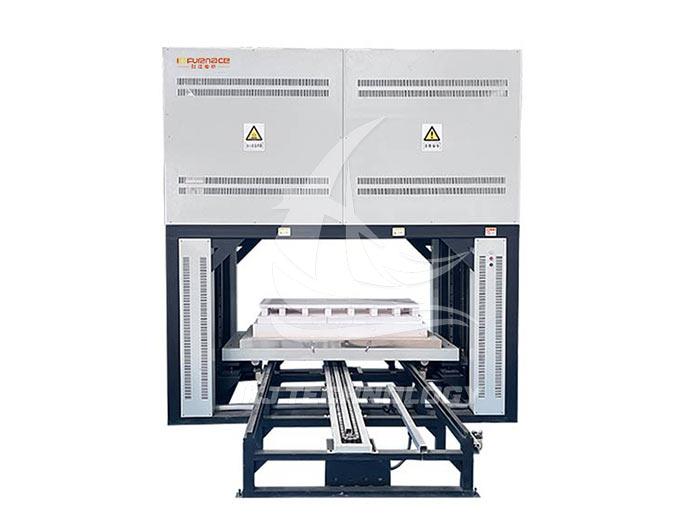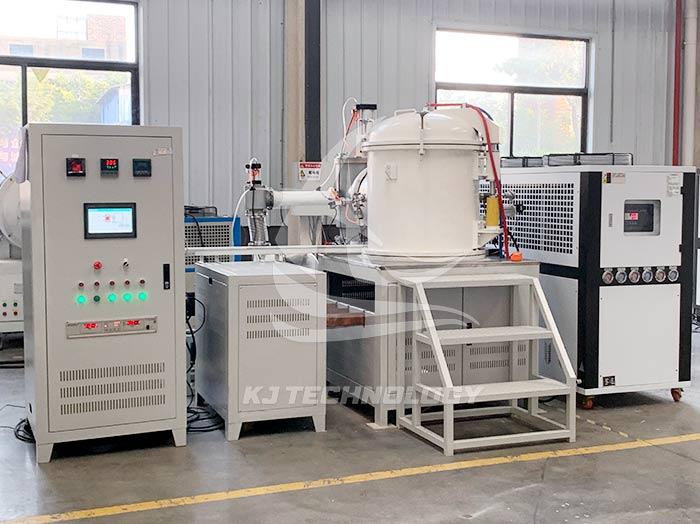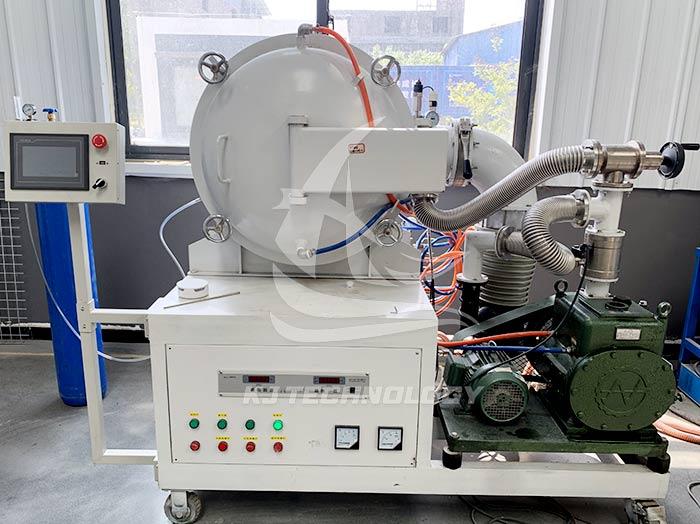Working principle of experimental vacuum hot press furnace
 09-22-2025 Author: KJ technology
09-22-2025 Author: KJ technology
The experimental vacuum hot press furnace is an advanced material preparation equipment that integrates vacuum environment, high-temperature heating, and mechanical pressure. Its working principle achieves material densification and performance optimization through the collaborative action of multiple systems. The following is a detailed analysis of its core working principle:
1. System composition and functions
The experimental vacuum hot press furnace mainly consists of the following five systems, which work together to complete material preparation:
vacuum system
Composition: mechanical pump, molecular pump, vacuum valve, vacuum gauge, etc.
Function:
Vacuumize to the maximum vacuum degree (usually ≤ 6.7 × 10 ⁻ ³ Pa), eliminate gases such as oxygen and water vapor in the furnace, and prevent material oxidation.
Maintain a vacuum environment during the sintering process to prevent metal (such as cobalt) from evaporating or reacting with gases at high temperatures.
Example: When sintering WC Co hard alloy, the vacuum degree needs to be stable below 10 ⁻ ² Pa to suppress cobalt phase oxidation.
heating system
Composition: Graphite heater, thermocouple, temperature controller, etc.
Function:
Raise the temperature inside the furnace to the target value (up to 2200 ℃) through resistance heating or induction heating.
Adopting zone temperature control technology (independent control of the upper, middle, and lower zones) to ensure temperature uniformity (within ± 5 ℃).
Example: When sintering silicon nitride ceramics, it is necessary to keep the temperature at 1700-1800 ℃ and control the heating rate at 5-10 ℃/min to prevent thermal shock cracking.
pressurized system
Composition: hydraulic cylinder, pressure sensor, mold, etc.
Function:
Apply unidirectional or bidirectional pressure (up to 300 MPa) through hydraulic devices to promote powder particle rearrangement and densification.
The pressure can be dynamically adjusted with temperature changes (such as gradually increasing pressure to the target value during the heating stage).
Example: When preparing metal based composite materials, a pressure of 50 MPa needs to be applied at 1200 ℃ to promote the interface bonding between metal and ceramic.
cooling system
Composition: Water cooling jacket, circulating water pump, emergency cooling device, etc.
Function:
Quickly cool the furnace body and mold to prevent material deformation or equipment damage at high temperatures.
The emergency cooling system can automatically start when there is a power outage, ensuring that the furnace temperature drops to a safe range within 3 minutes.
Example: After sintering is completed, it is necessary to cool at a rate of 5 ℃/min to below 800 ℃ before filling with argon gas to avoid oxidation.
control system
Composition: PLC, touch screen, data acquisition module, etc.
Function:
Realize closed-loop control of temperature, pressure, and vacuum degree, supporting multi-stage program heating/pressurization.
Real time monitoring and recording of process parameters, generating traceable process curves.
Example: Through PLC control, a complex process of "500 ℃ insulation for 1 hour → 10 ℃/min heating up to 1400 ℃ → pressurization to 30 MPa" can be set.
2. Core working principle
The working process of the experimental vacuum hot press furnace can be divided into the following four stages, and each stage achieves material densification through system collaboration:
Loading and Vacuum Extraction Stage
Operation: Load the powder material into the graphite mold, place it in the furnace cavity, and seal it.
Principle:
The mechanical pump roughly pumps to below 10 Pa, and the molecular pump finely pumps to the ultimate vacuum degree.
The vacuum environment eliminates gas impurities and provides an inert atmosphere for subsequent sintering.
Example: When sintering alumina ceramics, it is necessary to reduce the partial pressure of water vapor in the furnace to below 10 ⁻⁴ Pa to prevent material hydrolysis.
Heating and preloading stage
Operation: Start the heating system while applying pre pressure (usually 20% -30% of the final pressure).
Principle:
At low temperatures (<500 ℃), molding agents (such as paraffin) evaporate, and preloading prevents material expansion and cracking.
When the temperature rises to 800-1000 ℃, the oxide film on the surface of the powder particles ruptures, and the metal bonding phase (such as cobalt) begins to melt.
Example: When preparing WC Co hard alloy, it is necessary to keep the temperature at 1000 ℃ for 30 minutes to allow the cobalt phase to uniformly infiltrate the WC particles.
High temperature and high pressure sintering stage
Operation: After reaching the target temperature (such as 1400 ℃), gradually increase the pressure to the final value (such as 30 MPa) and maintain insulation and pressure.
Principle:
Particle rearrangement: Pressure drives powder particles to move, fill gaps, and increase packing density.
Plastic flow: The metal bonding phase softens at high temperatures and fills the remaining pores through creep mechanism.
Diffusion mass transfer: Atoms promote densification through grain boundaries or bulk diffusion, forming metallurgical bonds.
Example: When sintering silicon nitride ceramics, liquid silicon nitride oxide (Si ₂ N ₂ O) promotes interparticle bonding, and pressure can lower the sintering temperature by 200-300 ℃.
Cooling and demolding stage
Operation: Cool at the set rate, fill with argon gas to break the vacuum, and then demold.
Principle:
Slow cooling (<10 ℃/min) reduces thermal stress and prevents material cracking.
Argon protection prevents materials from reacting with air at high temperatures.
Example: When preparing metal based composite materials, demolding should be done below 600 ℃ to prevent adhesion between the mold and the material.
3. Key technological advantages
The experimental vacuum hot press furnace achieves material performance optimization through the following techniques:
Inhibit oxidation and impurity pollution
Vacuum environment eliminates oxygen to prevent metal phase oxidation.
Reduce gas impurity adsorption and improve material purity.
Promote densification
Under pressure assistance, the material density can reach over 99.5% (usually 95% -98% for atmospheric sintering).
The porosity is reduced to below 0.5%, significantly improving hardness and wear resistance.
refined grain
Short term high-temperature sintering suppresses grain growth.
Fine grain structure improves material toughness and fatigue resistance.
Realize complex shape forming
Powder exhibits thermoplasticity during the hot pressing process and can be molded into complex structures such as thin-walled tubes and irregular parts in one go.
Reduce subsequent processing steps and lower manufacturing costs.
4. Application scenario examples
Preparation of Hard Alloy Cutting Tools
Process: WC-10% Co powder, hot pressed sintering at 1450 ℃/30 MPa.
Effect: The hardness of the tool is HRA 92, the wear resistance is improved compared to atmospheric sintering, and the service life is extended.
Ceramic metal composite material connection
Process: Hot press diffusion bonding of Al ₂ O ∝ ceramics and Kovar alloy at 1000 ℃/20 MPa.
Effect: The joint shear strength is higher, meeting the sealing requirements of electronic packaging.
Densification of nanomaterials
Process: Nano TiO ₂ powder, hot pressed sintering at 800 ℃/50 MPa.
Effect: The grain size is controlled at 50 nm, and the photocatalytic activity is higher than that of conventional ceramics.








